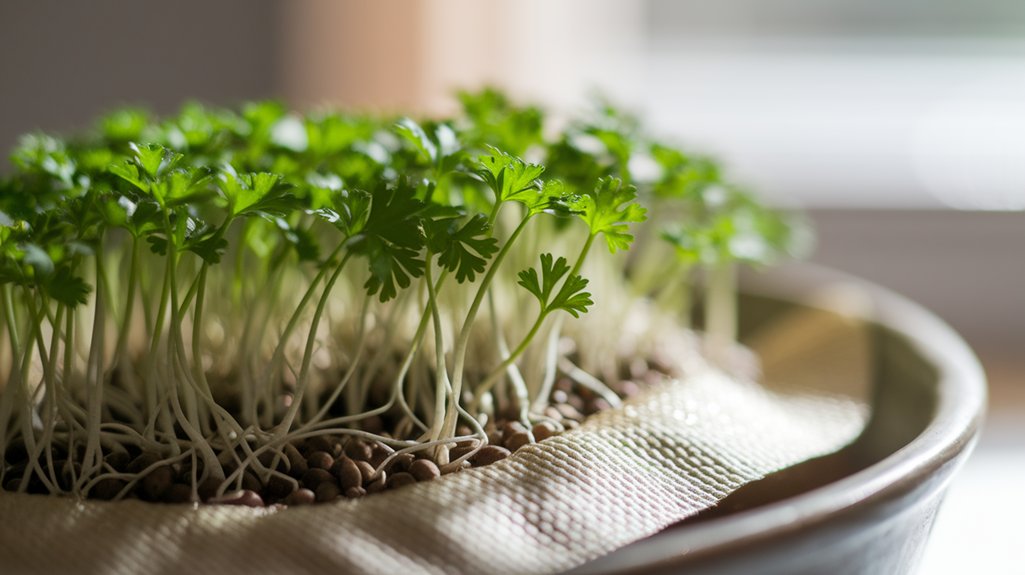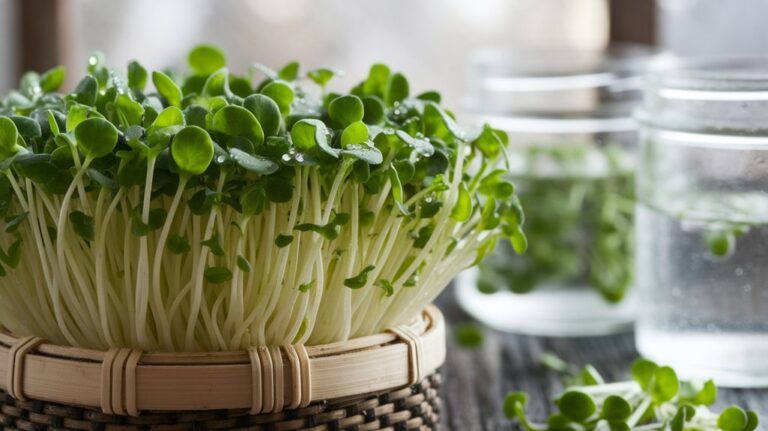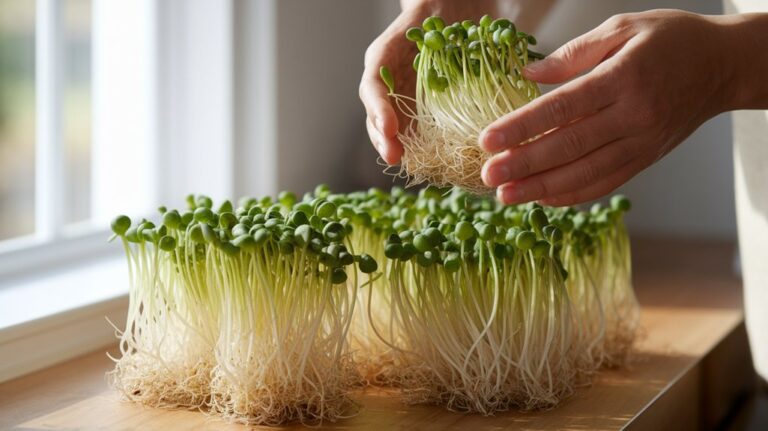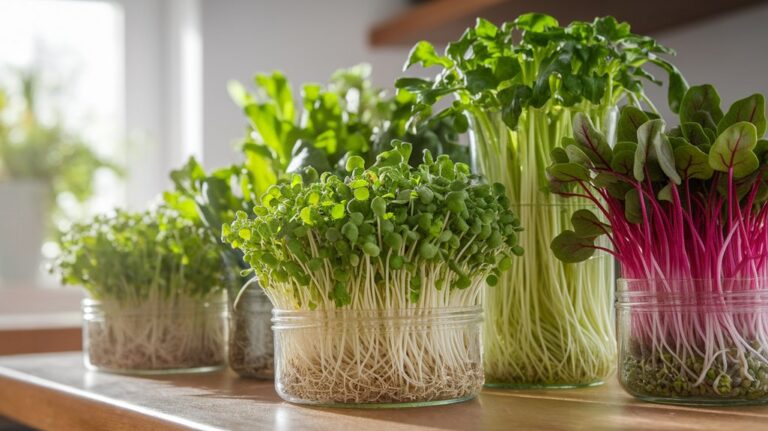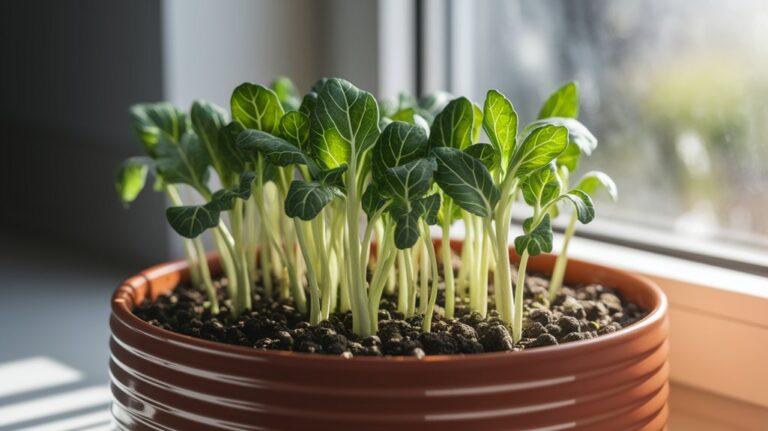How to Sprout Parsley
To sprout parsley, I first choose high-quality seeds, preferably organic for better nutrients. I soak them in warm water for 24 hours, then place them on a damp paper towel. Next, I plant the seeds in shallow, well-draining containers, covering them lightly with soil. I keep them in indirect sunlight and maintain consistent moisture. Regularly, I’ll use balanced fertilizer and thin crowded seedlings. If you stick around, I’ll share tips on harvesting and storing your fresh parsley!
Key Takeaways
- Soak parsley seeds in warm water for 24 hours to help soften the seed coat before planting.
- Use shallow containers with drainage, filled with well-draining soil, to plant the soaked seeds.
- Space seeds about 12 inches apart, cover lightly with soil, and mist to maintain moisture.
- Place the container in a location with indirect sunlight for 6-8 hours daily to promote growth.
- Water consistently to keep the soil moist without over-saturating, and use fertilizer every four to six weeks.
Understanding the Benefits of Sprouting Parsley
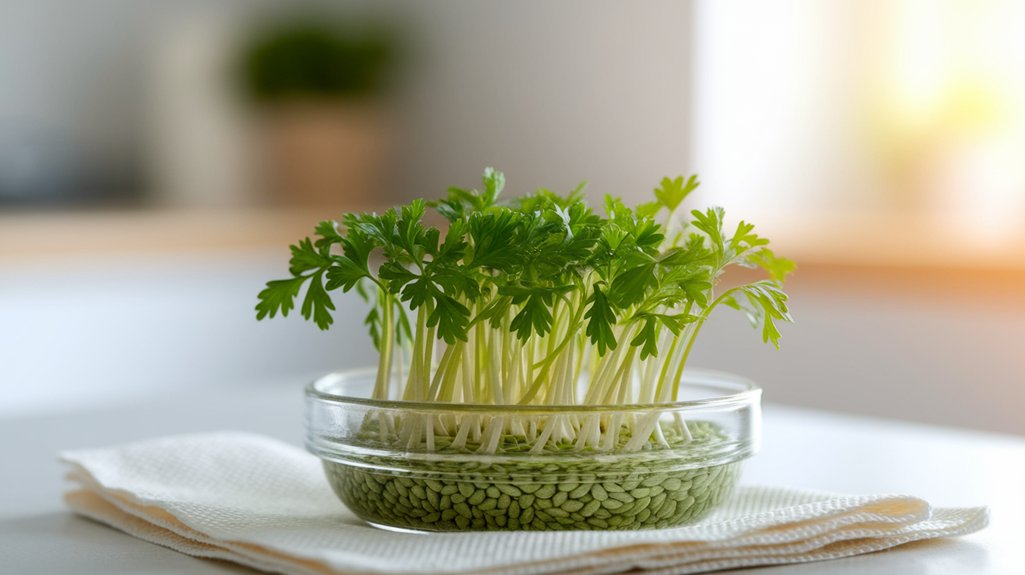
Sprouting parsley offers a delightful opportunity to enhance both flavor and nutrition in our meals. When I sprout parsley, I’m not just adding a fresh herb; I’m incorporating a powerhouse of vitamins and antioxidants.
The sprouting process increases the bioavailability of nutrients, making them easier for our bodies to absorb. I find that sprouted parsley contains higher levels of vitamins A, C, and K compared to its mature counterpart.
Additionally, the sprouting process can enhance the herb’s flavor profile, giving dishes a brighter, more vibrant taste. By incorporating sprouted parsley into my salads, sandwiches, and garnishes, I’m elevating my culinary creations while boosting their nutritional value.
It’s a simple yet effective way to improve our meals and overall health.
Choosing the Right Seeds
When I choose parsley seeds, I consider the variety options available, as some types have unique flavors and growth characteristics.
I also weigh the benefits of organic versus non-organic seeds, as this can affect both the sprouting process and my gardening philosophy.
Finally, I ensure that I source my seeds from reliable suppliers to guarantee quality and germination success.
Seed Variety Options
Choosing the right seeds for sprouting parsley is crucial for ensuring healthy growth and vibrant flavor. When I’m selecting seeds, I consider different varieties that can influence my culinary experience.
Each type has unique characteristics, so here’s what I focus on:
- Flat-Leaf Parsley: Known for its robust flavor and ease of use in cooking.
- Curly-Leaf Parsley: Often used as a garnish, it has a milder taste and attractive appearance.
- Italian Parsley: A favorite among chefs, it offers a strong flavor and is great for fresh applications.
- Giant of Italy: This variety grows larger leaves and has a distinctive taste, perfect for larger dishes.
Organic vs. Non-Organic
The decision between organic and non-organic seeds can significantly impact the quality of your parsley.
Organic seeds are derived from plants grown without synthetic pesticides or fertilizers, promoting a healthier ecosystem. When I choose organic, I’m not just opting for a more natural growth process; I’m also supporting biodiversity and soil health.
Non-organic seeds, on the other hand, may offer quicker results and potentially higher yields, but they can carry residues from chemicals used in their cultivation. Additionally, some non-organic varieties may be genetically modified, which could affect the flavor and nutritional value of your parsley.
Ultimately, I prefer organic seeds for their purity and the assurance that I’m cultivating a healthier herb for my kitchen.
Seed Source Reliability
Reliable seed sources are crucial for successful parsley cultivation. I’ve learned that not all seeds are created equal, and choosing the right supplier can significantly impact your results.
When sourcing parsley seeds, consider these key factors:
- Reputation: Look for suppliers with positive reviews and proven track records.
- Seed Quality: Ensure seeds are fresh, viable, and free from diseases.
- Varietal Options: Choose a source that offers a variety of parsley types, such as flat-leaf or curly.
- Certifications: Check for organic or non-GMO certifications if that aligns with your gardening philosophy.
Preparing Your Sprouting Containers
When preparing my sprouting containers, I focus on selecting the right type that promotes healthy growth.
I ensure that each container has adequate drainage, as excess water can lead to rot and hinder the sprouting process.
Choosing the Right Container
Choosing the right container for sprouting parsley is crucial, as it directly impacts the success of your germination efforts. I’ve found that selecting a suitable container can make all the difference.
Here are some key factors to consider:
- Material: Opt for materials like plastic or ceramic that retain moisture but allow for airflow.
- Size: A shallow container about 2-3 inches deep is ideal; it provides enough room for root growth without wasting space.
- Shape: Choose a wide container, which maximizes the surface area for seeds and promotes even sprouting.
- Cleanliness: Ensure your container is clean and free from chemicals to prevent contamination.
Ensuring Proper Drainage
To ensure your parsley sprouts thrive, it’s essential to focus on proper drainage in your containers.
I always choose containers with drainage holes, as they prevent water from pooling at the bottom. If you’re using a non-draining container, like a decorative pot, I recommend adding a layer of gravel or small stones to facilitate drainage.
Additionally, I often opt for a well-aerated potting mix that allows excess moisture to escape. When watering, I aim for a balance—too much water can suffocate the roots, while too little can dry them out.
Soaking and Germination Process
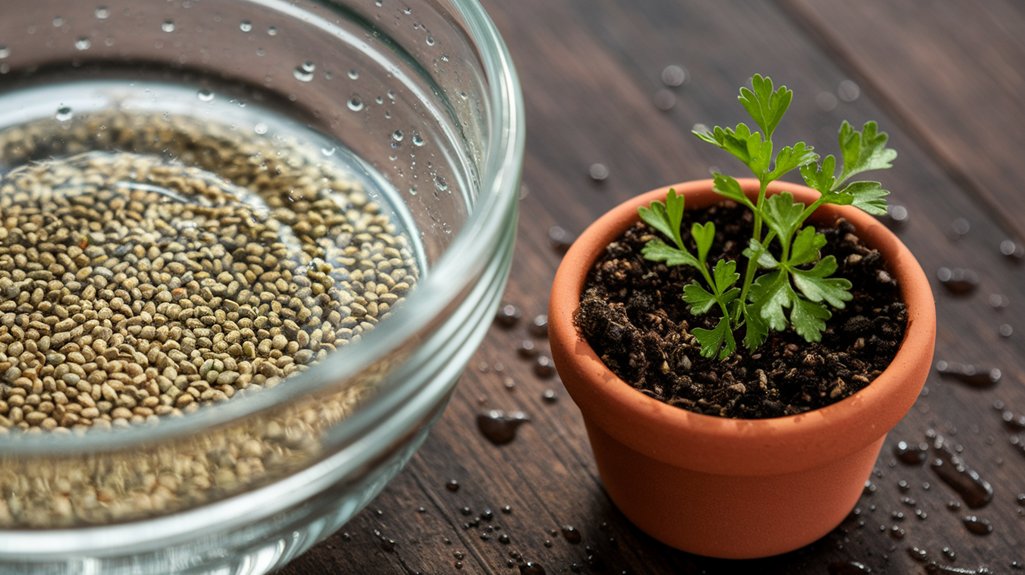
Although parsley seeds have a reputation for slow germination, understanding the soaking and germination process can significantly enhance your success rate. I’ve found that soaking the seeds beforehand is crucial. It softens the seed coat, allowing moisture to penetrate and triggers the germination process.
Here’s how I do it:
- Soak seeds in warm water for 24 hours, ensuring they’re fully submerged.
- Drain water and place seeds on a damp paper towel for a few hours to promote moisture absorption.
- Plant seeds in well-draining soil, spacing them about 12 inches apart.
- Cover lightly with soil and mist to maintain consistent moisture.
Caring for Your Sprouted Parsley
Once your parsley seeds have sprouted, caring for them properly is essential to ensure healthy growth.
I always start by placing my sprouted parsley in a location that receives plenty of indirect sunlight, ideally around 6-8 hours daily.
I maintain a consistent watering schedule, keeping the soil moist but not soggy, as overwatering can lead to root rot.
Using a balanced, water-soluble fertilizer every four to six weeks helps provide necessary nutrients.
I also thin out the seedlings if they’re overcrowded, ensuring each plant has enough space to grow.
Finally, I monitor for pests like aphids and remove any affected leaves promptly.
This attention to detail helps my parsley thrive and flourish beautifully.
Harvesting Your Parsley
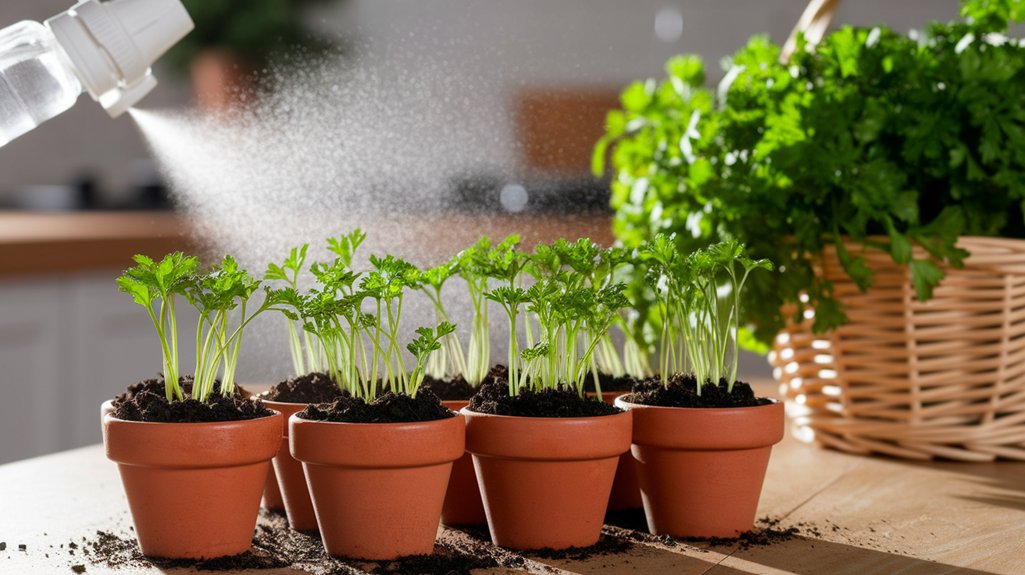
As I approach the harvesting stage of my parsley, I focus on timing and technique to ensure optimal flavor and plant health. Harvesting too early can result in underdeveloped flavor, while waiting too long may cause the leaves to become tough.
I typically start harvesting when the plants have at least 6 inches of growth. Here are some key points I consider during the process:
- Choose the right time: Early morning or late afternoon is ideal for harvesting.
- Use sharp scissors: Clean, sharp tools minimize damage to the plant.
- Select outer leaves: Harvest the larger, outer leaves first, allowing the center to continue growing.
- Don’t over-harvest: Always leave enough foliage to sustain the plant’s health and growth.
Tips for Storing and Using Fresh Parsley
After I’ve harvested my parsley, I focus on storing and using it effectively to maximize its flavor and freshness. I typically wash the leaves, then wrap them in a damp paper towel and place them in a breathable bag in the refrigerator. This keeps them crisp for about a week. For longer storage, I chop and freeze the parsley in ice cube trays with a bit of water or olive oil. Here’s a quick reference table for my preferred methods:
| Storage Method | Duration | Best Use |
|---|---|---|
| Refrigerator | 1 week | Salads, garnishes |
| Freezing | 6 months | Soups, sauces |
| Drying | Indefinite | Seasoning blends |
Utilizing these methods helps me enjoy fresh parsley year-round!
Frequently Asked Questions
Conclusion
In conclusion, sprouting parsley is a rewarding and straightforward process that enhances both your culinary creations and health. By choosing quality seeds, preparing the right containers, and diligently caring for your sprouts, you can enjoy fresh, nutrient-packed parsley right at home. Remember to harvest at the right time and store it properly to maximize its flavor and longevity. With these steps, you’ll not only cultivate a delightful herb but also deepen your connection to the food you prepare.

